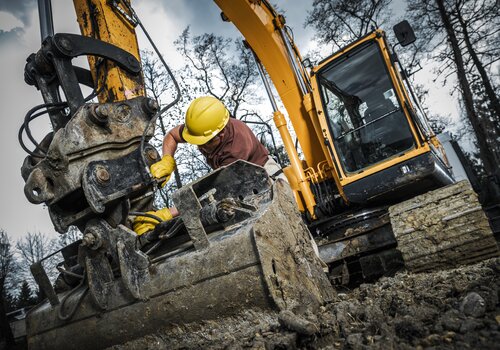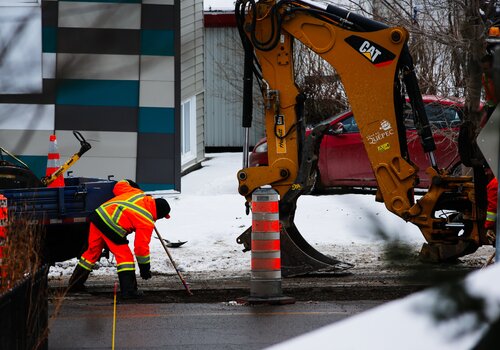Cold in-place recycling (CIR) has become an increasingly popular method for rehabilitating and maintaining roadways, presenting a sustainable alternative to traditional road reconstruction techniques. As the construction industry faces growing pressure to reduce environmental impacts and find cost-effective solutions, CIR stands out for its potential benefits. However, like any construction technique, it also comes with its challenges. Knowing the pros and cons of CIR, will help contractors weigh its viability for their projects.
WHAT IS COLD IN-PLACE RECYCLING?
CIR is a method of reconstructing asphalt pavement without heating. In this process, existing pavement is milled up to a specific depth and then mixed with new binders like asphalt emulsion or foamed bitumen on-site. This mixture is immediately laid down and compacted to form a new base layer. CIR reduces material costs, conserves resources and minimizes environmental impact by recycling the old pavement and reducing the need for transporting new materials. This technique is efficient for rehabilitating worn-out roads, enhancing their structural integrity and extending their lifespan.
PROS OF COLD IN-PLACE RECYCLING
Cost-Effectiveness
One of the most significant advantages of CIR is its cost-effectiveness. By recycling existing road materials, the need for new materials is drastically reduced. This not only cuts down the cost of raw materials but also reduces transportation and disposal expenses. Studies suggest that CIR can save up to 50% over traditional road reconstruction methods.
Environmental Benefits
CIR is highly regarded for its environmental benefits. The process uses existing asphalt, which decreases the demand for virgin aggregate and bitumen. This reduction in new material usage substantially lowers the carbon footprint associated with mining, manufacturing and transporting new materials. Moreover, CIR reduces landfill waste since the old pavement materials are recycled in place. Studies show that CIR can reduce GHG emissions by more than 60%.
Reduced Construction Time
Another significant advantage of CIR is the reduction in construction time. Since the process involves recycling the existing pavement on site, there is no need for the lengthy and disruptive process of excavating and hauling away old materials and bringing in new ones. Roads can be reopened more quickly, minimizing disruption to traffic and local businesses.
Improved Pavement Longevity
CIR can enhance the longevity of roadways by restoring the structural integrity of the existing pavement. The addition of new binders and the correction of structural failures during the recycling process can extend the life of the road surface, reducing the frequency and cost of future repairs.
Versatility
CIR is versatile in addressing various pavement distresses such as cracking, raveling and moisture infiltration. It can be tailored to different situations by adjusting the depth of recycling, the type of binder used and the mix design, making it suitable for a wide range of road conditions.
One of the most significant advantages of CIR is its cost-effectiveness. By recycling existing road materials, the need for new materials is drastically reduced.
CONS OF COLD IN-PLACE RECYCLING
Weather Dependency
CIR is more sensitive to weather conditions than traditional paving methods. The process requires warmer temperatures and dry weather to ensure proper curing of the recycled material. This can limit the window of opportunity for projects, particularly in regions with long winters or unpredictable weather patterns.
Equipment Availability and Cost
Implementing CIR requires specialized equipment that can be costly to purchase and maintain. Not all contractors have immediate access to the necessary machinery, such as recyclers and tankers for binder distribution. Renting or acquiring this equipment can be a significant upfront investment.
Performance Variability
The success of CIR can vary based on the condition of the original pavement and the quality of the execution. If the existing road contains contaminants or the recycled material is not adequately mixed or compacted, the final surface may not meet expected performance standards. This variability can pose risks for contractors guaranteeing long-term durability.
Skilled Labor Requirements
CIR processes require skilled operators and technicians who understand the complexities of the equipment and the nuances of the materials involved. Finding and training such personnel can be challenging and expensive, adding to project costs.
Limited Depth of Treatment
CIR is generally limited to the top 3 to 6 inches of pavement, which means it is not suitable for addressing deeper structural issues in the road base. For roads requiring comprehensive rehabilitation, CIR may need to be supplemented with other techniques, potentially complicating the project and eroding some of the cost and time savings.
NAVIGATING THE DECISION
For construction contractors considering CIR, the decision to use this method should be based on a thorough analysis of the project-specific conditions, including the existing pavement state, environmental considerations, budget constraints and available equipment and expertise. While CIR offers compelling advantages in terms of cost, speed and environmental impact, it also demands careful planning and execution to avoid the pitfalls associated with its limitations.
5 Tips to Determine if CIR is Right for Your Project
- Assess Pavement Condition
Examine the current condition of the pavement to determine if it's a suitable candidate for CIR. CIR is most effective on pavements with surface distress but still has a stable base. Significant base failures or deep structural issues may require more extensive reconstruction methods. - Evaluate Material Suitability
Analyze the existing asphalt material to ensure it can be effectively recycled. Testing for material properties such as asphalt content, aggregate gradation and presence of contaminants (like tar or metal pieces) is crucial. Unsuitable materials can lead to poor performance of the recycled pavement. - Consider Weather and Seasonal Constraints
Since CIR is sensitive to weather conditions, consider the typical climate of the project area. The process requires dry conditions and warmer temperatures for the recycled material to cure properly. Avoid planning CIR in regions with prolonged cold or wet seasons during the expected project timeline. - Calculate Cost-Effectiveness
Perform a cost analysis comparing CIR with traditional methods. Include considerations for material savings, reduced transportation and disposal costs, and potential for quicker project completion. However, also factor in the costs of renting or purchasing necessary equipment and any additional surface treatments required after recycling. - Review Equipment and Expertise Availability
Ensure that you have access to the specialized equipment needed for CIR and that your team has the required expertise or can receive appropriate training. Lack of proper equipment or skilled personnel can hinder the successful implementation of CIR and affect the quality of the finished roadway.
Stay tuned to the CONEXPO-CON/AGG 365 newsletter as we dive deeper into more pavement recycling techniques. If you missed the first article in this series, check it out here.
Photo credit: BEEKEEPX/BIGSTOCKPHOTO.COM












